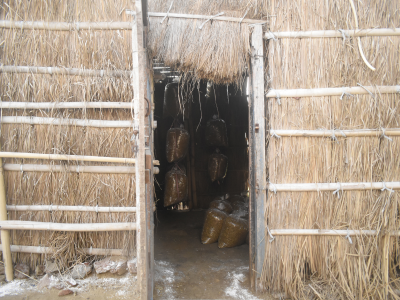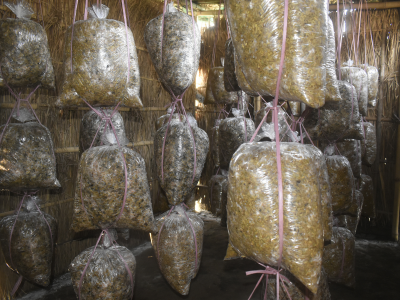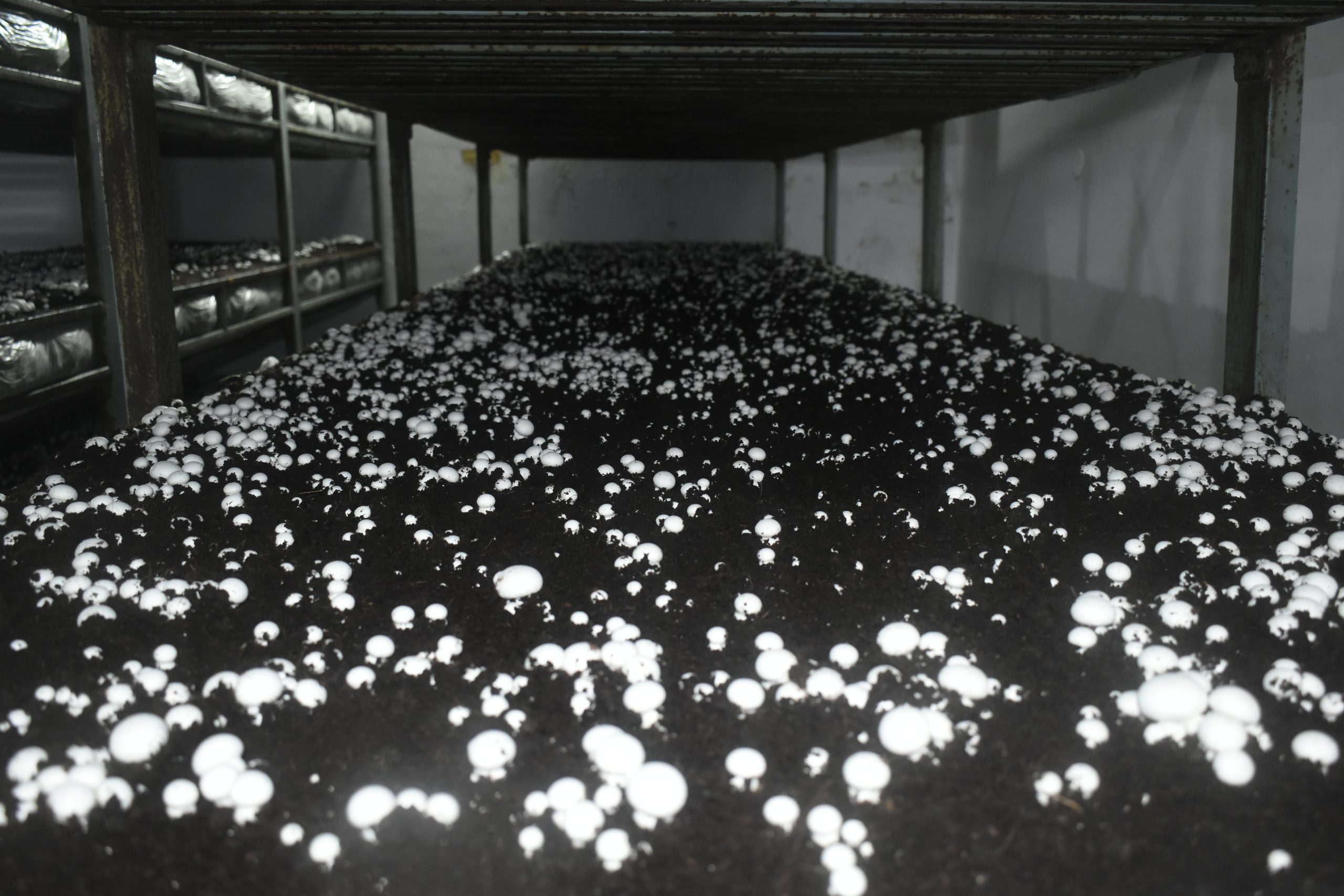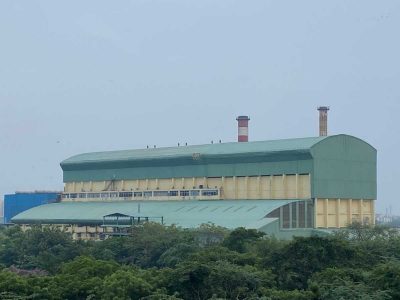Sitting amid vast fields in Dhansa, a village situated in southwest Delhi and bordering the Capital, Narendra Dagar is making quite a difference through his small huts.
Rows of polythene bags suspended with strings along the roof separate this ordinary-looking hut from others.
“This is my passion and I intend to make a difference,” smiles Dagar.
Once a traditional farmer, Dagar now operates a mushroom facility and training centre from these huts.
The suspended plastic bags comprise compost made of agricultural waste such as straws, wheat chaff, and more. On a closer look, visitors see white veins running through this compost which has been kept under dark.
Dagar says these are mycelium.

“A lot of steps are involved in mushroom farming and lack of due diligence can result in failure of crops,” he says.
Primarily growing three types of mushrooms, namely oyster, milky, and button, Dagar claims it involves many steps, ranging from preparation of compost to choice of spawn to name a few.
“It is a scientific endeavour with students coming from as far as Ladakh to gain practical knowledge of this wonderful fungi,” he states.
Mushroom farming also draws big players.
Pawan Kumar runs permanent mushroom farming unit in Hasanpur village, an urban village in East Delhi. The village once boasted multiple permanent units generating income for many. However, Pawan’s farming unit stands alone now.
“This business isn’t as profitable as claimed by many,” he states.
According to him, temperature-controlled setups require a vast amount of finance, labour, and training. The first step involves the selection of good compost, as even minor pH changes can lead to crop failure.
“Farmers often lack this testing equipment and are forced to rely on texture and smell of the mix,” he states.
Spawns, one of the first stages in the life-cycle of mushrooms, do not run in the presence of high ammonia levels. Thus, some farmers choose to visit government testing sites for spawn health.
“I recently had to face a loss of Rs 6 lakh due to bad quality spawn,” says Kumar.

The constituents of compost vary depending on a region’s cropping patterns, as rice straws, wheat chaff, and sugarcane waste make their appearance.
Kumar is unable to manufacture his compost as his residential zone has been declared as an urban area. According to him, he could have saved money by producing his compost.
Clean pristine environments are a prerequisite for mushroom cultivation as he, along with his family members, sanitise the cultivation rooms before putting compost in the beds. The temperature is maintained at a constant 25 degree Celsius with humidity levels kept as high as 80%. The room is once again sanitised with high-pressure water.
After 10-15 days, with mycelium running across the compost, casing soil usually made of peat is then added to the mix.
“The casing soil helps in maintaining carbon dioxide, and moisture and provides a firm support to the growing mushrooms,” explains Kumar.
In the next fifteen days, mushrooms begin sprouting from the bed with multiple flushes of cultivation. In the first flush, standard-sized mushrooms are picked with nutrients being left for the smaller mushrooms in the second and third flush. Kumar points out that mushrooms become commercially viable only at a certain size. Within two months, a cultivation cycle is finally completed.
“Despite all the hard work with a team of labourers keeping an eye on the blooming mushrooms, business has been tough,” he sighs.
Margins on mushroom cultivation are less, complain many farmers.
One cultivator from Ujwa village states that he has been forced to halt his units for the winter as prices dip further due to overproduction owing to the presence of seasonal units.
“I have had to close a few of my units in the last two years since profit has been less than expected,” he sighs.
“These seasonal units in the Capital function usually from November to March when temperatures are conducive for mushrooms,” tells Dagar.
Button Mushrooms dominate the Indian mushroom landscape, constituting around 80% of the production.
According to a paper released by scholars from Tamil Nadu Agricultural University (TNAU), production of mushrooms in India has boomed from around 9 million tonnes in 1991 to around 243 million tonnes in 2021.
However, the bright production numbers also reflect a distressed export sector and a dependent import streak.
In 1991, India would go on to export 5.7 million tonnes of mushrooms. But exports fell to a mere one million tonnes in 2021. The development takes place as China and other East Asian countries continue to capture markets in the West.
An official from the Directorate of Mushroom Research (DMR), a pre-eminent research and training centre under the auspices of the Indian Agricultural Centre (ICAR) and situated in Solan (Himachal Pradesh), states that in a training pool of 100 cultivators, only around 20 stay in the cultivation business.
“Most get discouraged after two to three years as output can often become low in the initial years with no mechanisms in place for purchase,” he explains.
According to him, large-scale seminars must be held for interested farmers with support extending beyond project management.
According to Ashok Kumar, Director of Delhi’s Horticulture Department, “The government helps farmers in constructing farming units with apt support in insight and project management. However, more concrete help in terms of minimum support price and subsidies are needed.
“Delhi lacks an agricultural policy, as the city rushes towards its urban dream forgetting farmers who toil for years,” claims Paras Tyagi, President of the Centre for Youth Culture, Law & Environment (CYCLE).
On the low margins received by farmers on their cultivation, Tyagi points towards the absence of a designated agricultural ministry in the Capital and not making farmers stakeholders.
“Even after all these years, Delhi doesn’t even have a farmers’ market,” he states.
Kumar echoes the same sentiment as he says he does not receive apt compensation for his mushrooms in mandis.
“We do not know what happens to our produce once it enters mandis. We do not get purchase records,” he states.
Kumar says that farmers are forced to work with prices set by arhtiyas (middlemen) in mandis.
According to a study by People’s Resource Centre, a non-profit based out of Delhi, the current population of Delhi, estimated at around 2.3 crores, requires 9-10 million tons of annual food.
Currently, only 10% of this demand is estimated to be met by in-boundary production in Delhi.
However, 15% of vegetables, 60% of meat, and 25% of milk being consumed are sourced locally.
“Mixing of commercial places like residential areas and parks in farming regions is common and the Delhi master plans do not address it,” claims Nishant Singh, an independent researcher.
According to him, there is more pressure on farmers to secure lands as they continue to deal with the production of perishable items.
“Even the casing soil being too hard can make bumps on mushrooms’ heads, fetching lower prices. It is very gentle as it is a fungus,” says Dagar.
Singh explains that lack of institutional support makes space for middle actors who exploit farmers.
“Agriculture supports a host of migrant workers and marginalised communities, contributing to economic output in Delhi,” he states.
Savita (33) is a member of a women’s self-help group that sells snacks, cookies, flour, and more things made from mushrooms.
Selling in wholesale quantities to states as far as Assam, with bookings confirmed over Whatsapp, she claims mushrooms have provided her with an income.
“I think that in this health-conscious age, mushrooms can be a big hit,” she says.
Savita says that her mushroom namkeens are a big hit and often the first to be sold out. However, most of the work is still done by hand as machines prove to be expensive.
“I have not yet turned to government schemes, as for now I do not wish to wander around government offices,” she complains.
Kumar says that though the government supports farmers with finance and expertise, many cultivators are yet to be reached.
“We need massive awareness programmes. The state needs to get involved in output purchase. He explains it would also encourage farmers to diversify their mushroom production as well.
“Button Mushroom, a choice of the majority of the farmers requires a temperate climate, thus making it suitable only for winters,” says the DMR official.
He explains that India is a diverse country with different climates and farmers should experiment with species that are more conducive to their native climates.
“The government should introduce mushrooms in mid-day meals as they are a high protein source. It will also introduce this wonderful product to new people,” he says.
Dagar continues to be hopeful for the industry.
“We have only started tapping into mushrooms’ potential, we have a long way ahead but it will be exciting,” he says.





